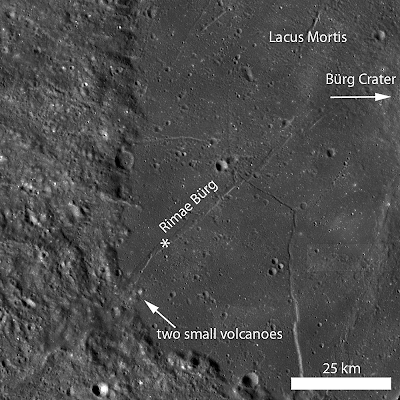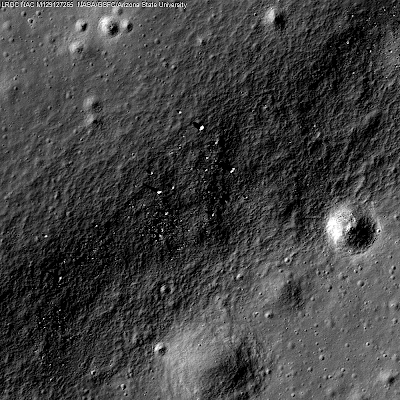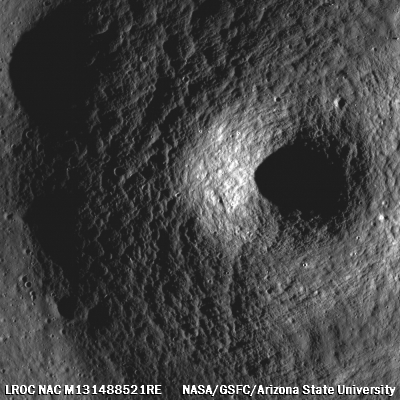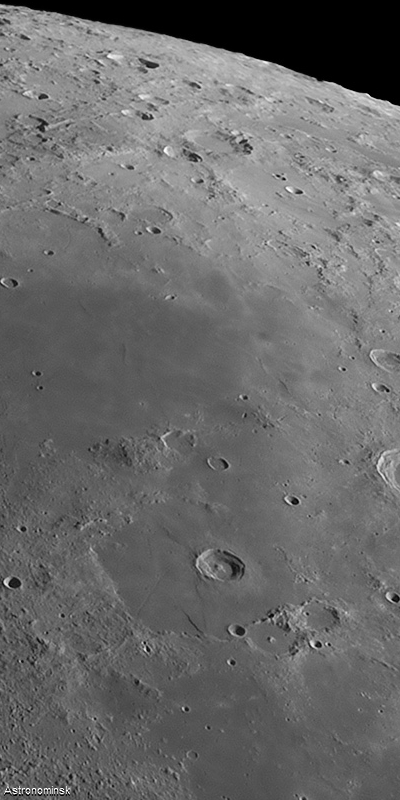Rimae Bürg is a linear rille with an average width of 2 kilometers. The feature runs more than 60 kilometers through Lacus Mortis, "the lake of death," and continues into the highland terrain where it becomes obscured and reappears as a ridge. Illumination is from the west, and the star designates the location of the LROC Narrow Angle Camera highlighted as the LROC Featured Image, February 12, 2011. View the full-sized annotated mosaic, HERE [NASA/GSFC/Arizona State University].
A portion of the shadowed, southern wall of Rimae Bürg is visible a subset of LROC Narrow Angle Camera observation M129127265R (LRO orbit 4163, May 22, 2010). The rille floor (upper left) is flat, attesting to the horst-graben normal faulting invoked by many as an underlying cause of the formation of many linear rilles on the Moon. Image field of view is 500 meters; illumination is from the west. View the full-sized frame HERE [NASA/GSFC/Arizona State University].
 Lillian Ostrach
Lillian OstrachLROC News System
Traverse the length of Rimae Bürg in the LROC Wide Angle Camera (WAC) monochrome mosaic or explore the rille floor in the LROC the Narrow Angle Camera (NAC) image!
Most of the craters on the Moon formed through impact processes. However, some craters, like the one visible in this portion of LROC NAC frame M131488521R (LRO orbit 4511, June 18, 2010), may be a volcano summit pit crater. Crater diameter is ~400 meters and the image field of view is 923 meters; illumination is from the east [NASA/GSFC/Arizona State University].
A Commissioning Phase Narrow Angle Camera observation from 162.4 kilometers (resolution 1.61 m/p) of the pyroclastic formation where Rimae Bürg crosses up from Lacus Mortis mare material and continues southeast through highland terrain - evidence the surface feature is a manifestation of a deeper rift. LROC NAC frame M102006420R, LRO orbit 512, July 12, 2009 [NASA/GSFC/Arizona State University].
LROC Wide Angle Camera monochrome (689nm) mosaic showing 41km Bürg crater lording over central Lacus Mortis in a relatively high sun; swept up in LRO orbits 1208-1211 on October 1, 2009. Rimae Bürg transects the western shield and the two older worn craters familiar to Earth-bound telescopic observers that accompany "the lake of death" lie outside it's southern and southeastern edge, 46km Playa and pummeled into poor definition 44km Mason (r). View a larger version HERE [NASA/GSFC/Arizona State University].
The "Elephant Skin" phenomena, a nearly ubiquitous dusty cross-hatch pattern on lunar slopes, may be a very appropriate term for a feature on the Moon after all. This montage of 19 LROC NAC and WAC frames, fixed to a Clementine albedo image of west Lacus Mortis, shows any single close-up of the Moon is like "the blind men and the elephant" revealing only a single set of features, and these only as they are seen under one state of illumination and conditions. A great many observations are needed to obtain a comprehensive picture of our dynamic "inconstant Moon" [NASA/DOD/GSFC/Arizona State University].
Close-up on Lacus Mortis from of one of the really outstanding full lunar disk mosaics by Yuri Goryachko, Mikhail Abgarian & Konstantin Morozov of Astonominsk in Minsk, Belarus (Mosaic of 12 images, April 21, 2010) [Astronominsk].
Related Posts:
Linear Graben
Volcanoes in Lacus Mortis
Rupes Recta
Rimae Bradley
Older Posts:
Not your average complex crater
Lunar morphology in the lake of death
Blogger's Best for the Best
Terraced Wall of Bürg








No comments:
Post a Comment